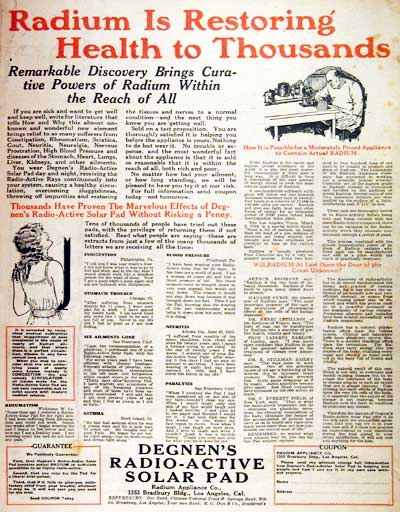This is an image of brass stencil that was used to identify products made by women during WWII.

Found here thanks to Breck C.
This is an image of brass stencil that was used to identify products made by women during WWII.

Found here thanks to Breck C.
Vietnam-era anti-draft propaganda from The Draft Resistance offers girls to pacifist boys.

From Vintage Ads via Jezebel.
In a 1987 article titled “Sex and Death in the Rational World of Defense Intellectuals,” Carol Cohn discussed the way in which “defense intellectuals” (the scientists and strategists behind war) used language that was rife with sexual metaphors, sexual imagery, and the promise of sexual domination. Here are some of the words and phrases she heard these men (mostly) use to refer to military weapons:
“penetration aids”
“vertical erector launchers”
“thrust-to-weight ratios”
“soft lay downs”
“deep penetration”
“protracted versus spasm attacks”
“releasing… megatonnage in one orgasmic whump”
India’s first explosion of a nuclear bomb described as “losing her virginity” and then the United States asked whether they should “throw her away.”
An explanation of why the MX missile is to be placed in new silos: “because they’re in the nicest hole—you’re not going to take the nicest missile you have and put it in a crummy hole”
One journalist described a nuclear blast like this:
“Then, just when it appeared as though the thing had settled down into a state of permanence, there came shooting out of the top a giant mushroom that increased the size of the pillar to a total of 45,000 feet. The mushroom top was even more alive than the pillar, seething and boiling in a white fury of creamy foam, sizzling upward and then descending earthward, a thousand geysers rolled into one. It kept struggling in an elemental fury, like a creature in the act of breaking the bonds that held it down.”
With this in mind, consider the costume worn by Miss Atomic Bomb (1957). Yes that is a mushroom cloud or, dare I say, an “orgasmic whump” spreading out all over her. A full-size cardboard cut-out Miss Atomic Bomb, that is Lee Merlin, welcomed Gwen and I to the Atomic Testing Museum in Las Vegas. Here she is in all her glory:
I want to give a shout-out to Vivek who mentioned Merlin in response to our previous post on the Atomic Testing Museum.
Reference: Cohn, Carol. 1987. Sex and Death in the Rational World of Defense Intellectuals. Signs 12, 4: 687-718.
Lisa Wade, PhD is an Associate Professor at Tulane University. She is the author of American Hookup, a book about college sexual culture; a textbook about gender; and a forthcoming introductory text: Terrible Magnificent Sociology. You can follow her on Twitter and Instagram.
One of my students last semester wrote a paper in which she looked at sexist images of Condoleezza Rice. Interestingly, much of the online discourse was very similar to the way people talk negatively about Hillary Clinton. It was fascinating to see the same themes used by people with different political viewpoints in their criticisms–both Hillary and Condoleezza were described as bitches and whores and as ugly man-hater lesbians. My student argued persuasively that the reason the online attacks on the two women were so similar was because they weren’t being viewed as politicians or through the lens of their policies, but instead the attacks used a sexist lens that focused on their femaleness–and willingness to trespass on male-dominated political terrain–as the thing to attack, rather than any specific action or policy. Unfortunately for the blog, though good for humanity, I didn’t find as many images that had been made to accompany the hateful rhetoric about Condi as about Hillary.
Here’s an image (found here) I came across (note that George Bush’s face has been super-imposed on the handler):

Both Hillary and Condi are often described as ugly. However, I noticed when searching for images of Condoleezza that both supporters and critics occasionally sexualized her (especially in reference to a pair of stiletto-heeled boots that got a lot of public attention at one point). I haven’t found similar images of Hillary from either supporters or critics (whether it would be preferable to be sexualized by a supporter or opponent, I’m not sure). I found this image of Condi in a bathtub here, though it was posted on several other websites I came across in a really brief search.

This bathing suit image came from here.

Unsurprisingly, Condoleezza’s race is also a focus in online discussions in a way that Hillary’s isn’t, such as this image (found here) that plays on the idea of the Uncle Tom (the implication being that Black Republicans or military hawks are puppets used by Whites for their own agenda–that is, that they are either duped or are trying to get power by appeasing Whites):

NEW: p.j. sent in this sexualized picture of Condi:
Thanks, p.j.!
Lisa and I went to the Atomic Testing Museum in Las Vegas today. We were not allowed to take pictures! However, we were inspired to post about the word “atomic.” Below are some pictures related to the U.S. bombing of Nagasaki during WWII. They are followed by some examples of the way in which the word “atomic” has been taken up in popular culture
The mushroom cloud over Nagasaki, Japan:

Nagasaki before and after the U.S. dropped an atomic bomb (found here):

Together the bombs dropped by the U.S. on Nagasaki and Hiroshima killed between 150,000 and 220,000 people immediately (that is, not considering the long-term morbidity and mortality). For more on the science of atomic bombs and the structural and human casualties of the Hiroshima and Nagasaki bombings, click here. Our point here is to point out that at this point in history, the word “atomic” referred to something incredibly devastating to human life.
Given this, we find it fascinating that the word came to mean something like “cool,” “super extra much,” “hot and spicy” and numerous other vague references to awesomeness. Then, the adjective could be used to describe anything at all. Consider the following examples
Clothes and sporting equipment:
Music-related stuff:
Candy:
So at some time and for some reason, the word “atomic” came to refer not to something very, very serious and instead to something very, very fun. How odd. We did a search for the etymology of the word “atomic” and there was nothing to explain how the word came to be used that way in popular American culture. In fact, there was no reference to its non-scientific use at all.
P.S. – If you’re ever in Las Vegas and want to see something very, very weird (sociologically, we mean), we suggest the Atomic Testing Museum. There, you can learn about America’s proud “atomic testing heritage.”
UPDATE: Commenter Elena pointed out that before the creation of the atomic bomb, people thought radiation promoted health. An ad for a radioactive “solar pad,” basically a radioactive belt people were supposed to wear:

Found here.
A radium water filter:

Found here.
It seems odd to me that after the devastation the atomic bombs caused in Japan, the word “atomic” and atomic materials such as uranium retained any positive connotations in the public realm.
Gwen Sharp is an associate professor of sociology at Nevada State College. You can follow her on Twitter at @gwensharpnv.
The trouble is… people will answer them.
Found here thanks to commenter Phili-Chan! From an Australian show featuring Charles Firth.
The propaganda below, from World War II, was distributed by the U.S. government. In the posters, venereal disease (later known as sexually transmitted disease, and even later as sexually transmitted infections) is personified as a woman. Remember, venereal disease is NOT a woman. It’s bacteria or virus that passes between women and men. Women do not give it to men. Women and men pass it to each other. When venereal disease is personified as a woman, it makes women the diseased, guilty party and men the vulnerable, innocent party.
In this ad, the soldier is made innocent with the label “The Young, The Brave, The Strong.” The first girl is labeled “prostitution.” She says to the soldier: “Two girls I know want to meet you in the worst way.” The two women on the stairs, with the faces of skeletons, are labelled “syphilis” and “gonnorhea.”

Text: “Warning: These enemies are still lurking around.” The women are labeled “syphillis” and “gonnorhea.”

This one is my favorite. A female skeleton in an evening gown walks with her arms around Hitler and Hirohito. The text reads: “V.D. Worst of the Three.”

Here are three more:



At least some of these can be found here. Thanks to the unbeatablekid pointing out a source in our comments.
NEW: Marc sent us a link to these images (all found here):
A pamphlet distributed to soldiers:
Thanks, Marc!
This Australian ad for Lipton tea suggests that it’s mind clarifying qualities are so good that it could help even George Bush achieve the feat of naming all 50 states.
This Brazilian ad for Rolling Stone, featuring a picture of George W. Bush, reads: “We don’t show naked women to sell more. At the most, we show some asses.”

This Chinese Greenpeace ad, portraying Bush’s spin on global warming, reads: “Everyone’s entitled to an opinion. Voice yours at forum.greenpeace.org.”
This Chinese ad for an erasable pen reads: “Everyone makes mistakes.”
In Malaysia, Bush is used to sell Smart cars. Text: “Still looking for weapons of mass destruction. Not smart.”

Also in Malaysia, Amnesty International makes fun of Bush in their effort to inspire opposition to Guantanamo Bay. “Write to him and help stop torture at Guantanamo Bay. Remember, use simple words.”

This is a Mexican ad for a dog kennel. “We don’t discriminate any kind of breed.” (The source says that, in Mexico, like in the U.S., “dog” is a name for a bad person.)
This ad for a Mexican newspaper reads: “Such a complex world needs a good explanation.”

This is an ad for the movie American Psycho in New Zealand.
In Portugal, playing war games (paint ball) is advertised as equivalent to playing George W. Bush.

This Swiss ad threatens, if you fall off your bicycle without a helmet, you may end up as dumb as George W. Bush.

These and more borrowed from here, found via adfreak.
Update: There have been some really nice points in the comments about how, in the process of making fun of Bush, we are also seeing the further stigmatization of “people with developmental disabilities, brain injuries, and psychological diagnoses” (that from Penny in the comments).